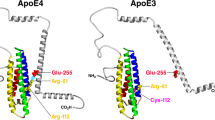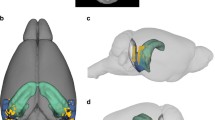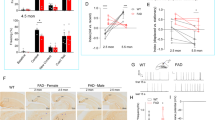Abstract
Progressive hippocampal degeneration is a key component of Alzheimer’s disease (AD) progression. Therefore, identifying how hippocampal neuronal function is modulated early in AD is an important approach to eventually prevent degeneration. AD-risk factors and signaling molecules likely modulate neuronal function, including APOE genotype and angiotensin II. Compared to APOE3, APOE4 increases AD risk up to 12-fold, and high levels of angiotensin II are hypothesized to disrupt neuronal function in AD. However, the extent that APOE and angiotensin II modulates the hippocampal neuronal phenotype in AD-relevant models is unknown. To address this issue, we used electrophysiological techniques to assess the impact of APOE genotype and angiotensin II on basal synaptic transmission, presynaptic, and post-synaptic activity in mice that express human APOE3 (E3FAD) or APOE4 (E4FAD) and overproduce Aβ. We found that compared to E3FAD mice, E4FAD mice have lower synaptic activity, but higher levels of paired-pulse facilitation (PPF) and long-term potentiation (LTP) in the Schaffer Collateral Commissural Pathway (SCCP) of the hippocampus. We also found that exogenous angiotensin II has a profound inhibitory effect on hippocampal LTP in both E3FAD and E4FAD mice. Collectively, our data suggests that APOE4 and Aβ are associated with a hippocampal phenotype comprised of lower basal activity and higher responses to high-frequency stimulation, the latter of which is suppressed by angiotensin II. These novel data suggest a potential mechanistic link between hippocampal activity, APOE4 genotype, and angiotensin II in AD.




Similar content being viewed by others
Data Availability
The datasets used and/or analyzed during the current study are provided as a supplementary file and are available from the corresponding author on reasonable request.
Abbreviations
- AD:
-
Alzheimer’s disease
- ARBs:
-
angiotensin receptor blockers
- AT1R:
-
angiotensin type 1 receptor
- aCSF:
-
artificial cerebrospinal fluid
- APP K670N/M671L + I716 V + V717I and PS1 M146L + L286 V:
-
EFAD mice: mice that express human APOE3- or APOE4- and 5 FAD mutations
- FAD:
-
familial AD models
- fEPSPs:
-
field excitatory post-synaptic potential
- HFS:
-
high-frequency stimulation
- LTP:
-
long-term potentiation
- PPF:
-
paired-pulse facilitation
- PTP:
-
post-tetanic potentiation
- SCCP:
-
Schaffer Collateral Commissural Pathway
References
Alzheimer’s disease facts and figures (2022) Alzheimers Dement. 18(4):700–789
Collaborators, G.B.D.D.F (2022) Estimation of the global prevalence of dementia in 2019 and forecasted prevalence in 2050: an analysis for the Global Burden of Disease Study 2019. Lancet. Public Health 7(2):e105–e125
Mufson EJ et al (2015) Hippocampal plasticity during the progression of Alzheimer’s disease. Neuroscience 309:51–67
Balestrieri JVL et al (1992) Structural volume of hippocampus and Alzheimer’s disease. Rev Assoc Med Bras 66(4):512–515
Scaduto P et al (2023) Functional excitatory to inhibitory synaptic imbalance and loss of cognitive performance in people with Alzheimer’s disease neuropathologic change. Acta Neuropathol 145(3):303–324
Liu CC et al (2013) Apolipoprotein E and Alzheimer disease: risk, mechanisms and therapy. Nat Rev Neurol 9(2):106–118
Liao F, Yoon H, Kim J (2017) Apolipoprotein E metabolism and functions in brain and its role in Alzheimer’s disease. Curr Opin Lipidol 28(1):60–67
Kerchner GA et al (2014) APOE epsilon4 worsens hippocampal CA1 apical neuropil atrophy and episodic memory. Neurology 82(8):691–697
Mueller SG, Weiner MW (2009) Selective effect of age, Apo e4, and Alzheimer’s disease on hippocampal subfields. Hippocampus 19(6):558–564
Wolk DA, Dickerson BC, I. Alzheimer’s Disease Neuroimaging (2010) Apolipoprotein E (APOE) genotype has dissociable effects on memory and attentional-executive network function in Alzheimer’s disease. Proc Natl Acad Sci U S A 107(22):10256–10261
Trommer BL et al (2004) ApoE isoform affects LTP in human targeted replacement mice. Neuroreport 15(17):2655–2658
Tai LM et al (2017) EFAD transgenic mice as a human APOE relevant preclinical model of Alzheimer’s disease. J Lipid Res 58(9):1733–1755
Liu DS et al (2015) APOE4 enhances age-dependent decline in cognitive function by down-regulating an NMDA receptor pathway in EFAD-Tg mice. Mol Neurodegener 10:7
Trivedi MA et al (2008) fMRI activation during episodic encoding and metacognitive appraisal across the lifespan: risk factors for Alzheimer’s disease. Neuropsychologia 46(6):1667–1678
Bookheimer SY et al (2000) Patterns of brain activation in people at risk for Alzheimer’s disease. N Engl J Med 343(7):450–456
Filippini N et al (2009) Distinct patterns of brain activity in young carriers of the APOE-epsilon4 allele. Proc Natl Acad Sci U S A 106(17):7209–7214
Kunz L et al (2015) Reduced grid-cell-like representations in adults at genetic risk for Alzheimer’s disease. Science 350(6259):430–433
Busche MA et al (2012) Critical role of soluble amyloid-beta for early hippocampal hyperactivity in a mouse model of Alzheimer’s disease. Proc Natl Acad Sci U S A 109(22):8740–8745
Billings LM et al (2005) Intraneuronal Abeta causes the onset of early Alzheimer’s disease-related cognitive deficits in transgenic mice. Neuron 45(5):675–688
Vyas Y, Montgomery JM, Cheyne JE (2020) Hippocampal deficits in amyloid-beta-related rodent models of Alzheimer’s disease. Front Neurosci 14:266
Trommer BL et al (2005) ApoE isoform-specific effects on LTP: blockade by oligomeric amyloid-beta1-42. Neurobiol Dis 18(1):75–82
Kitamura HW et al (2004) Age-dependent enhancement of hippocampal long-term potentiation in knock-in mice expressing human apolipoprotein E4 instead of mouse apolipoprotein E. Neurosci Lett 369(3):173–178
Korwek KM et al (2009) ApoE isoform-dependent changes in hippocampal synaptic function. Mol Neurodegener 4:21
Chen Y et al (2010) ApoE4 reduces glutamate receptor function and synaptic plasticity by selectively impairing ApoE receptor recycling. Proc Natl Acad Sci U S A 107(26):12011–12016
Lennon MJ et al (2019) Midlife hypertension and Alzheimer’s disease: a systematic review and meta-analysis. J Alzheimers Dis 71(1):307–316
de Gasparo M et al (2000) International union of pharmacology. XXIII. The angiotensin II receptors. Pharmacol Rev 52(3):415–472
Kehoe PG et al (2016) Angiotensin-converting enzyme 2 is reduced in Alzheimer’s disease in association with increasing amyloid-beta and tau pathology. Alzheimers Res Ther 8(1):50
Cosarderelioglu C et al (2022) Higher angiotensin II type 1 receptor levels and activity in the postmortem brains of older persons with Alzheimer’s dementia. J Gerontol A Biol Sci Med Sci 77(4):664–672
Ismael S et al (2021) Renin-angiotensin system alterations in the human Alzheimer’s disease brain. J Alzheimers Dis 84(4):1473–1484
Savaskan E et al (2001) Cortical alterations of angiotensin converting enzyme, angiotensin II and AT1 receptor in Alzheimer’s dementia. Neurobiol Aging 22(4):541–546
Mogi M et al (2008) Telmisartan prevented cognitive decline partly due to PPAR-gamma activation. Biochem Biophys Res Commun 375(3):446–449
Ongali B et al (2014) Angiotensin II type 1 receptor blocker losartan prevents and rescues cerebrovascular, neuropathological and cognitive deficits in an Alzheimer’s disease model. Neurobiol Dis 68:126–136
Torika N et al (2017) Intranasal telmisartan ameliorates brain pathology in five familial Alzheimer’s disease mice. Brain Behav Immun 64:80–90
Saavedra JM (2017) Beneficial effects of angiotensin II receptor blockers in brain disorders. Pharmacol Res 125(Pt A):91–103
Saavedra JM (2012) Angiotensin II AT(1) receptor blockers ameliorate inflammatory stress: a beneficial effect for the treatment of brain disorders. Cell Mol Neurobiol 32(5):667–681
Scheinman SB et al (2021) Systemic candesartan treatment modulates behavior, synaptic protein levels, and neuroinflammation in female mice that express human APOE4. Front Neurosci 15:628403
Davies NM et al (2011) Associations of anti-hypertensive treatments with Alzheimer’s disease, vascular dementia, and other dementias. J Alzheimers Dis 26(4):699–708
Saavedra JM (2016) Evidence to consider angiotensin II receptor blockers for the treatment of early Alzheimer’s disease. Cell Mol Neurobiol 36(2):259–279
Loera-Valencia R et al (2021) Brain renin-angiotensin system as novel and potential therapeutic target for Alzheimer’s disease. Int J Mol Sci 22(18)
Singh MR, Vigh J, Amberg GC (2021) Angiotensin-II modulates GABAergic neurotransmission in the mouse substantia nigra. eNeuro 8(2)
Richards EM et al (1999) Angiotensin II type 1 receptor-modulated signaling pathways in neurons. Mol Neurobiol 19(1):25–41
Pan HL (2004) Brain angiotensin II and synaptic transmission. Neuroscientist 10(5):422–431
Mooney RD, Zhang Y, Rhoades RW (1994) Effects of angiotensin II on visual neurons in the superficial laminae of the hamster’s superior colliculus. Vis Neurosci 11(6):1163–1173
Li DP, Pan HL (2005) Angiotensin II attenuates synaptic GABA release and excites paraventricular-rostral ventrolateral medulla output neurons. J Pharmacol Exp Ther 313(3):1035–1045
Li DP, Chen SR, Pan HL (2003) Angiotensin II stimulates spinally projecting paraventricular neurons through presynaptic disinhibition. J Neurosci 23(12):5041–5049
Youmans KL et al (2012) APOE4-specific changes in Abeta accumulation in a new transgenic mouse model of Alzheimer disease. J Biol Chem 287(50):41774–41786
Church E et al (2022) Synaptic integration of subquantal neurotransmission by colocalized G protein-coupled receptors in presynaptic terminals. J Neurosci 42(6):980–1000
Zaldua S et al (2020) Epidermal growth factor treatment of female mice that express APOE4 at an age of advanced pathology mitigates behavioral and cerebrovascular dysfunction. Heliyon 6(5):e03919
Bashir ZI et al (1991) Long-term potentiation of NMDA receptor-mediated synaptic transmission in the hippocampus. Nature 349(6305):156–158
Cochilla AJ, Alford S (1998) Metabotropic glutamate receptor-mediated control of neurotransmitter release. Neuron 20(5):1007–1016
Leung LS, Fu XW (1994) Factors affecting paired-pulse facilitation in hippocampal CA1 neurons in vitro. Brain Res 650(1):75–84
Santschi LA, Stanton PK (2003) A paired-pulse facilitation analysis of long-term synaptic depression at excitatory synapses in rat hippocampal CA1 and CA3 regions. Brain Res 962(1-2):78–91
Jackman SL, Regehr WG (2017) The mechanisms and functions of synaptic facilitation. Neuron 94(3):447–464
Opitz B (2014) Memory function and the hippocampus. Front Neurol Neurosci 34:51–59
Takeuchi T, Duszkiewicz AJ, Morris RG (2014) The synaptic plasticity and memory hypothesis: encoding, storage and persistence. Philos Trans R Soc Lond B Biol Sci 369(1633):20130288
Bao JX, Kandel ER, Hawkins RD (1997) Involvement of pre- and postsynaptic mechanisms in posttetanic potentiation at Aplysia synapses. Science 275(5302):969–973
Bliss TV, Collingridge GL (1993) A synaptic model of memory: long-term potentiation in the hippocampus. Nature 361(6407):31–39
Langdon RB, Johnson JW, Barrionuevo G (1995) Posttetanic potentiation and presynaptically induced long-term potentiation at the mossy fiber synapse in rat hippocampus. J Neurobiol 26(3):370–385
Sastry BR, Goh JW, Auyeung A (1986) Associative induction of posttetanic and long-term potentiation in CA1 neurons of rat hippocampus. Science 232(4753):988–990
Tran TT et al (2017) Increased hippocampal activation in ApoE-4 carriers and non-carriers with amnestic mild cognitive impairment. Neuroimage Clin 13:237–245
Nichols LM et al (2012) Interactive effect of apolipoprotein e genotype and age on hippocampal activation during memory processing in healthy adults. Arch Gen Psychiatry 69(8):804–813
Diaz-Arrastia R et al (2003) Increased risk of late posttraumatic seizures associated with inheritance of APOE epsilon4 allele. Arch Neurol 60(6):818–822
Liang Y et al (2019) Association of apolipoprotein E genotypes with epilepsy risk: a systematic review and meta-analysis. Epilepsy Behav 98(Pt A):27–35
Gouras GK et al (1997) Increased apolipoprotein E epsilon 4 in epilepsy with senile plaques. Ann Neurol 41(3):402–404
Lamoureux L et al (2021) APOE4 promotes tonic-clonic seizures, an effect modified by familial Alzheimer’s disease mutations. Front Cell Dev Biol 9:656521
Lynch MA (1998) Analysis of the mechanisms underlying the age-related impairment in long-term potentiation in the rat. Rev Neurosci 9(3):169–201
Barnes CA (2003) Long-term potentiation and the ageing brain. Philos Trans R Soc Lond B Biol Sci 358(1432):765–772
Nuriel T et al (2017) Neuronal hyperactivity due to loss of inhibitory tone in APOE4 mice lacking Alzheimer’s disease-like pathology. Nat Commun 8(1):1464
Sun GZ et al (2017) Hippocampal synaptic and neural network deficits in young mice carrying the human APOE4 gene. CNS Neurosci Ther 23(9):748–758
Qiao F et al (2014) Apolipoprotein E4 impairs in vivo hippocampal long-term synaptic plasticity by reducing the phosphorylation of CaMKIIalpha and CREB. J Alzheimers Dis 41(4):1165–1176
Balducci C et al (2011) The gamma-secretase modulator CHF5074 restores memory and hippocampal synaptic plasticity in plaque-free Tg2576 mice. J Alzheimers Dis 24(4):799–816
Gong B et al (2004) Persistent improvement in synaptic and cognitive functions in an Alzheimer mouse model after rolipram treatment. J Clin Invest 114(11):1624–1634
Chang EH et al (2006) AMPA receptor downscaling at the onset of Alzheimer’s disease pathology in double knockin mice. Proc Natl Acad Sci U S A 103(9):3410–3415
Kimura R, Ohno M (2009) Impairments in remote memory stabilization precede hippocampal synaptic and cognitive failures in 5XFAD Alzheimer mouse model. Neurobiol Dis 33(2):229–235
D’Amelio M et al (2011) Caspase-3 triggers early synaptic dysfunction in a mouse model of Alzheimer’s disease. Nat Neurosci 14(1):69–76
Richards JG et al (2003) PS2APP transgenic mice, coexpressing hPS2mut and hAPPswe, show age-related cognitive deficits associated with discrete brain amyloid deposition and inflammation. J Neurosci 23(26):8989–9003
Palop JJ et al (2007) Aberrant excitatory neuronal activity and compensatory remodeling of inhibitory hippocampal circuits in mouse models of Alzheimer’s disease. Neuron 55(5):697–711
Mango D et al (2019) Targeting synaptic plasticity in experimental models of Alzheimer’s disease. Front Pharmacol 10:778
Zaman SH et al (2000) Enhanced synaptic potentiation in transgenic mice expressing presenilin 1 familial Alzheimer’s disease mutation is normalized with a benzodiazepine. Neurobiol Dis 7(1):54–63
Parent A et al (1999) Synaptic transmission and hippocampal long-term potentiation in transgenic mice expressing FAD-linked presenilin 1. Neurobiol Dis 6(1):56–62
Oddo S et al (2003) Triple-transgenic model of Alzheimer’s disease with plaques and tangles: intracellular Abeta and synaptic dysfunction. Neuron 39(3):409–421
Auffret A et al (2009) Age-dependent impairment of spine morphology and synaptic plasticity in hippocampal CA1 neurons of a presenilin 1 transgenic mouse model of Alzheimer’s disease. J Neurosci 29(32):10144–10152
Davis KE, Fox S, Gigg J (2014) Increased hippocampal excitability in the 3xTgAD mouse model for Alzheimer’s disease in vivo. PLoS One 9(3):e91203
Tuminello ER, Han SD (2011) The apolipoprotein e antagonistic pleiotropy hypothesis: review and recommendations. Int J Alzheimers Dis 2011:726197
Han SD, Bondi MW (2008) Revision of the apolipoprotein E compensatory mechanism recruitment hypothesis. Alzheimers Dement 4(4):251–254
Kazim SF et al (2017) Early-onset network hyperexcitability in presymptomatic Alzheimer’s disease transgenic mice is suppressed by passive immunization with anti-human APP/Abeta antibody and by mGluR5 blockade. Front Aging Neurosci 9:71
Hijazi S et al (2020) Early restoration of parvalbumin interneuron activity prevents memory loss and network hyperexcitability in a mouse model of Alzheimer’s disease. Mol Psychiatry 25(12):3380–3398
Najm R, Jones EA, Huang Y (2019) Apolipoprotein E4, inhibitory network dysfunction, and Alzheimer’s disease. Mol Neurodegener 14(1):24
Flowers SA, Rebeck GW (2020) APOE in the normal brain. Neurobiol Dis 136:104724
Konings SC et al (2021) Astrocytic and neuronal apolipoprotein E isoforms differentially affect neuronal excitability. Front Neurosci 15:734001
Larramona-Arcas R et al (2020) Sex-dependent calcium hyperactivity due to lysosomal-related dysfunction in astrocytes from APOE4 versus APOE3 gene targeted replacement mice. Mol Neurodegener 15(1):35
Ramakrishna S et al (2021) APOE4 affects basal and NMDAR-mediated protein synthesis in neurons by perturbing calcium homeostasis. J Neurosci 41(42):8686–8709
Veinbergs I et al (2002) Neurotoxic effects of apolipoprotein E4 are mediated via dysregulation of calcium homeostasis. J Neurosci Res 67(3):379–387
Berridge MJ (2011) Calcium signalling and Alzheimer’s disease. Neurochem Res 36(7):1149–1156
Dumanis SB et al (2013) APOE genotype affects the pre-synaptic compartment of glutamatergic nerve terminals. J Neurochem 124(1):4–14
Weeber EJ et al (2002) Reelin and ApoE receptors cooperate to enhance hippocampal synaptic plasticity and learning. J Biol Chem 277(42):39944–39952
Wright JW, Harding JW (2019) Contributions by the brain renin-angiotensin system to memory, cognition, and Alzheimer’s disease. J Alzheimers Dis 67(2):469–480
Jackson L et al (2018) Within the brain: the renin angiotensin system. Int J Mol Sci 19(3)
Trigiani LJ et al (2018) Pleiotropic benefits of the angiotensin receptor blocker candesartan in a mouse model of Alzheimer disease. Hypertension 72(5):1217–1226
Royea J et al (2020) AT2R’s (angiotensin II type 2 receptor’s) role in cognitive and cerebrovascular deficits in a mouse model of Alzheimer disease. Hypertension 75(6):1464–1474
Ouk M et al (2021) The use of angiotensin-converting enzyme inhibitors vs. angiotensin receptor blockers and cognitive decline in Alzheimer’s disease: the importance of blood-brain barrier penetration and APOE epsilon4 carrier status. Alzheimers Res Ther 13(1):43
Qiu WQ et al (2013) Angiotensin converting enzyme inhibitors and the reduced risk of Alzheimer’s disease in the absence of apolipoprotein E4 allele. J Alzheimers Dis 37(2):421–428
Barnes KL, DeWeese DM, Andresen MC (2003) Angiotensin potentiates excitatory sensory synaptic transmission to medial solitary tract nucleus neurons. Am J Physiol Regul Integr Comp Physiol 284(5):R1340–R1353
Xiong H, Marshall KC (1994) Angiotensin II depresses glutamate depolarizations and excitatory postsynaptic potentials in locus coeruleus through angiotensin II subtype 2 receptors. Neuroscience 62(1):163–175
Denny JB et al (1991) Angiotensin II blocks hippocampal long-term potentiation. Brain Res 567(2):321–324
von Bohlenund Halbach O, Albrecht D (1998) Angiotensin II inhibits long-term potentiation within the lateral nucleus of the amygdala through AT1 receptors. Peptides 19(6):1031–1036
Lu WY et al (2000) In CA1 pyramidal neurons of the hippocampus protein kinase C regulates calcium-dependent inactivation of NMDA receptors. J Neurosci 20(12):4452–4461
Xiong ZG et al (1998) Regulation of N-methyl-D-aspartate receptor function by constitutively active protein kinase C. Mol Pharmacol 54(6):1055–1063
Funding
This work was supported by National Institutes of Health grants R01AG061114 (LMT), R61NS114353 (LMT), R01MH086507 (KYT), and University of Illinois at Chicago Institutional funds (LMT & KYT).
Author information
Authors and Affiliations
Contributions
L. M. T., S. B. S., S. A., and K. Y. T. designed the study and interpreted data. S. B. S. conducted experiments. L. M. T., S. B. S., and S. A. wrote the manuscript. All authors read and approved the final manuscript.
Corresponding author
Ethics declarations
Research Involving Human Participants and/or Animals
This article does not contain any studies with human participants performed by any of the authors.
Ethical Approval
All protocols follow the UIC Institutional Animal Care and Use Committee protocols.
Consent to Participate
Not applicable.
Consent for Publication
Not applicable.
Conflict of Interest
The authors declare no competing interests.
Additional information
Publisher’s Note
Springer Nature remains neutral with regard to jurisdictional claims in published maps and institutional affiliations.
Rights and permissions
Springer Nature or its licensor (e.g. a society or other partner) holds exclusive rights to this article under a publishing agreement with the author(s) or other rightsholder(s); author self-archiving of the accepted manuscript version of this article is solely governed by the terms of such publishing agreement and applicable law.
About this article
Cite this article
Scheinman, S.B., Tseng, K.Y., Alford, S. et al. Higher Neuronal Facilitation and Potentiation with APOE4 Suppressed by Angiotensin II. Mol Neurobiol 61, 120–131 (2024). https://doi.org/10.1007/s12035-023-03556-9
Received:
Accepted:
Published:
Issue Date:
DOI: https://doi.org/10.1007/s12035-023-03556-9




